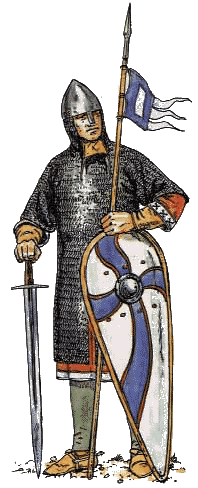 |
Norman Knight C. 1066
For hundreds of years, the basic form of body Armour consisted of
the chain-mail shirt, called the hauberk, or byrnie. In one form or
another, this was an essential piece of body defence until the late
fifteenth century. We have ample evidence in the Bayeux tapestry of
the equipment worn and carried by the Norman knights who rode to victory
at Hastings; they had knee-length mail hauberks with elbow-length
sleeves, split at front and rear for ease when riding, conical helmets
with a nasal bar, and leather or padded cloth greaves. Only very high
ranking lords wore mail stockings to protect their legs and feet.
Norman knights carried long, kite-shaped shields, often decorated
with swirling shapes like this one, though there is no evidence that
these decorations were associated with specific knights or families
in the heraldic sense. Their main weapons were a sword and a long
lance; the Saxons, by contrast, are often depicted wielding battle-axes
and carrying smaller, round shields.
|
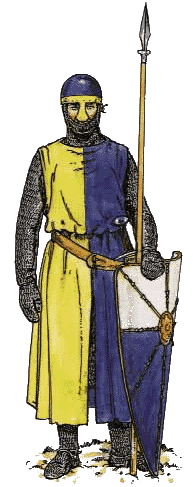 |
Norman Knight C.1180
The knight's Armour and equipment has not fundamentally changed for
a hundred years, but it has undergone a process of improvement and
refinement. The mail hauberk, worn over a tunic tightly padded with
wool and called a gambeson, is just below knee-length and the arms
have been extended to incorporate mittens. The knight slides his hands
in and out of the mittens through a slit at the wrist, which is then
laced up. His legs and feet are now also encased in mail. Over his
hauberk he wears a long, sleeveless, loose fitting surcoat, which
may bear his own distinctive device - the first beginnings of heraldry
. His helmet is now round, the better to deflect blows and missiles,
with a larger nasal bar. The neck of the hauberk extends into an aventail
- which is laced to the helmet with thongs. His sword has the characteristic
"fish tail" pommel, and his lance a broader blade with lugs
to prevent too deep penetration into opponents' bodies. His shield
has become shorter and more triangular in shape.
|
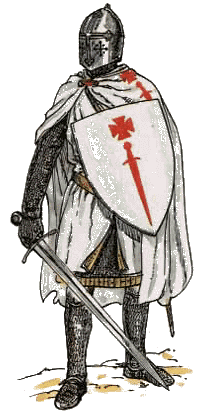 |
Teutonic Knight C. 1270
This Teutonic knight is one of the remnants of the Schwertbroder
- the Brethren of the Sword, a rather disreputable minor military
Order who had been instrumental in the conversion of Livonia (modern
day Latvia and Estonia). Most of the members were killed in a massacre
when they were surprised on an expedition into Lithuania, and the
survivors were incorporated into the Teutonic Knights in 1237. By
1270 knights helms were once more domed over the crown of the head,
since the curving surface deflected glancing blows. On top of the
helm is a fitting where a crest can be attached. The hauberk is growing
shorter and a gambeson is just visible beneath it. The shield is now
much smaller and shaped like an iron. For this reason they are called
heater-shields. The poleyns have been enlarged so that they completely
cover the knee joint at front and sides. The sword has a new-style
wheel shaped pommel.
|
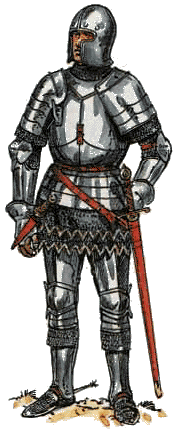 |
Italian Knight C. 1400
The harness of this knight represents a late stage in the transition
from mail to plate. His plate Armour is complete but he still wears
an aventail and a habergeon. His bascinet is fitted with the characteristic
"pig-faced" visor, which, when lowered, protected his face
completely in battle. The breast plate has been in use for some time,
and now has developed such refinements as a protruding socket at the
right arm-pit on which the knight can rest his lance as he charges.
His gauntlets are becoming bell-shaped; the fingers are made of canvas.
Plate Armour now covers the legs front and rear (though as yet he
does not wear a back-plate); greaves and cuissed are in two parts,
hinged at the inner leg seam. The winged plates on poleyns and couters
offer extra protection. The knight might still wear a jupon over his
Armour, but with this amount of plate defence, the shield is becoming
obsolete.
|
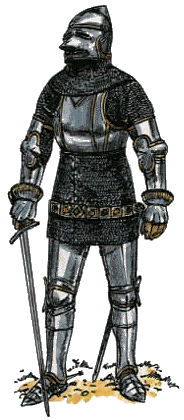 |
Italian Knight C. 1425
In the fifteenth century plate Armour really came into its own and
mail was worn only to supplement it at vulnerable joints or at areas
which needed extra mobility such as hip and groin. This knight is
obviously wealthy, because he is wearing a suit of Milanese Armour
of the finest quality. Northern Italy shared with Germany a reputation
for producing the finest Armour, and developed a characteristic, rounded
style. To go with the body harness he could choose from two types
of helmet; a close fitting armet which covered his entire head, tapering
at the neck, or a sallet, as here, a more open style, which did not
enclose the chin and throat, but had a curving neck guard behind.
This one is a "Ventian" style sallet, with open face instead
of a visor. His shoulders are protected by pauldrons, he wears both
breast and back plates, and these are extended with overlapping plates
to cover his hips. He wears mail chausses with fashionable long spurs.
|
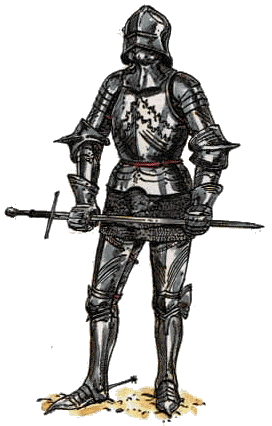 |
German Knight C. 1470-80
This knight is wearing a German, or "Gothic" harness, which
can be distinguished from the Italian by the more angular, spiky appearance.
It tends to be ornate and exaggerated; often the surface of the plates
were rippled or fluted, and their edges were cusped. German armourers
liked to decorate plates with points, and here we can see typically
pointed sabatons on the knight's feet, poleyns on his knees, couters
at the elbows, and gauntlet cuffs. The breast-plate was often made
in two parts, the lower overlapping the upper and rising to a point
in the centre. The knight wears a Gothic-style sallet (helmet) with
a closed face, his chin and throat are protected by a separate piece
of plate Armour called a bevor which was attached to the breast-plate.
The knight's lower body is protected by a mail skirt, but on top of
this he could also wear two plates called tassets to protect his upper
thighs, which strapped on to his breast-plate. His sword is a "hand-and-a-half"
sword with longer blade and grip.
|